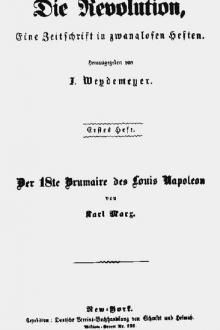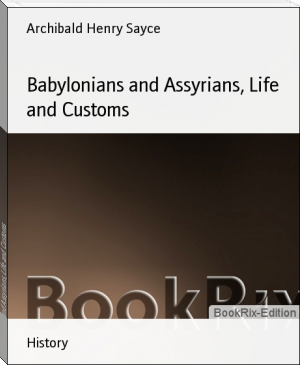Travels in France during the years 1814-1815 by Patrick Fraser Tytler (best e ink reader for manga .txt) 📕

These causes, operating gradually for a length of time, have probably produced that remarkable politeness of manners which is so pleasing to a stranger, in a number of the lower orders in France, and which appears so singular at the present time, as revolutionary ideas, military habits, and the example of a military court, have given a degree of roughness, and even ferocity, to the manners of many of the higher orders of Frenchmen, with which it forms a curious contrast. It is, however, in its relation to Englishmen at least, a fawning, cringing, interested politeness; less truly respecta
Read free book «Travels in France during the years 1814-1815 by Patrick Fraser Tytler (best e ink reader for manga .txt) 📕» - read online or download for free at americanlibrarybooks.com
- Author: Patrick Fraser Tytler
- Performer: -
Read book online «Travels in France during the years 1814-1815 by Patrick Fraser Tytler (best e ink reader for manga .txt) 📕». Author - Patrick Fraser Tytler
PARIS—THE LOUVRE.
To those who have had the good fortune to see the pictures and statues which were preserved in the Louvre, all description of these works must appear superfluous; and to those who have not had this good fortune, such an attempt could convey no adequate idea of the objects which are described. There is nothing more uninteresting than the catalogue of pictures which are to be found in the works of many modern travellers; nor any thing in general more ridiculous than the ravings of admiration with which this catalogue is described, and with which the reader in general is little disposed to sympathise. Without attempting, therefore, to enumerate the great works which were there to be met with, we shall confine ourselves to a simpler object, to the delineation of the general character by which the different schools of painting are distinguished, and the great features in which they all differ from the sculpture of ancient times. For the justice of these observations, we must of course appeal to those who have examined this great collection; and in the prosecution of them, we pretend to nothing more than the simple account of the feelings which, we are persuaded, must have occurred to all those who have viewed it without any knowledge of the rules which art has established, or the more despicable principles which connoisseurs have maintained.
For an attempt of this kind, the Louvre presented, singular advantages, from the unparalleled collection of paintings of every school and description which was there to be met with, and the facility with which you could trace the progress of the art from its first beginning to the period of its greatest perfection. And it is in this view that the collection of these works into one museum, however much to be deplored as the work of unprincipled ambition, and however much it may have diminished the impression which particular objects, from the influence of association, produced in their native place, was yet calculated, we conceive, to produce the greatest of all improvements in the progress of the art, by divesting particular schools and particular works of the unbounded influence which the effect of early association, or the prejudices of national feeling, have given them in their original situation, and placing them where their real nature is to be judged of by a more extended circle, and subjected to the examination of more impartial sentiments.
The character of every school of painting has been determined by some peculiar circumstances under which that school first originated, which have contributed to form its greatest excellencies, and been the real source of its principal defects; and it has unfortunately happened, that the unbounded admiration for the great production of these schools has everywhere formed the national taste, and tended to perpetuate their errors, when the progress of society would otherwise have led to their earlier abandonment. It deserves well to be considered, therefore, whether the restoration of these monuments of art to their original situations, while it must unquestionably enhance the veneration with which they will severally be regarded, may not perpetuate the defects which particular circumstances have stamped on their school of composition; and whether the continuance of them in one vast collection, however fatal to the implicit veneration for the works of antiquity, was not calculated, by the comparison of their excellencies and the exhibition of their defects, to form a new school, possessed of a more general character, and adapted for the admiration of a more unbiassed public. It is in the despotic reign of arbitrary governments, if we may be allowed, in a discussion on matters of taste, to borrow an illustration from politics, that the influence of ancient error, and the power of ancient prejudice, is most unbounded; but it is in the unbiassed discussion which distinguishes a free state, that the influence of prejudice is forgotten, and truth emerges from the collision of opposite opinions. However this may be, it will not, it is hoped, be deemed an useless attempt, if we now endeavour to state, in a few words, the impression which was produced by this great collection of the works of art, which has been felt, we doubt not, by all who have viewed it with untutored eyes, but has not hitherto been described by those so much better able to do justice to it than ourselves.
The first hall of the Louvre in the Picture Gallery is filled with paintings of the French school. The principal artists whose works are here exhibited are, Le Brun, Gaspar and Nicolas Poussin, Claude Lorrain, Vernet, and the modern painters Gerard and David. The general character of the school of French historical painting, is the expression of passion and violent emotion. The colouring is for the most part brilliant; the canvas crowded with figures, and the incident selected, that in which the painter might have the best opportunity of displaying his knowledge of the human frame, or the varied expression of the human countenance. In the pictures of the modern school of French painting, this peculiarity is pushed to an extravagant length, and, fortunately for the art, displays the false principles on which the system of their composition is founded. The moment seized is uniformly that of the strongest and most violent passion; the principal actors in the piece are represented in a state of phrenzied exertion, and the whole anatomical knowledge of the artist is displayed in the endless contortions into which the human frame is thrown. In David's celebrated picture of the three Horatii, this peculiarity appears in the most striking light. The works of this artist may excite admiration, but it is the limited and artificial admiration of the schools; of those who have forgot the end of the art in the acquisition of the technical knowledge with which it is accompanied, or the display of the technical powers which its execution involves.
The paintings of Vernet, in this collection, are perhaps the finest specimens of that beautiful master, and they entitle him to a higher place in the estimation of mankind than he seems yet to have obtained from the generality of observers. There is a delicacy of colouring, an unity of design, and a harmony of expression in his works, which accord well with the simplicity of the subjects which his taste has selected, and the general effect which it was his object to produce. In the representation of the sun dispelling the mists of a cloudy morning; of his setting rays gilding the waves of a western sea; or of that undefined beauty which moonlight throws over the objects of nature, the works of this artist are perhaps unrivalled.
The paintings of Claude are by no means equal to what we had expected, from the celebrity which his name has acquired, or the matchless beauty which the engravings from him possess. They are but eleven in number, and cannot be in any degree compared with those which are to be found in Mr Angerstein's collection. To those, however, who have been accustomed to study the designs of this great master, through the medium of the engraved copies, and above all, in the unrivalled works of Woollet, the sight of the original pictures must, perhaps at all times, create a feeling of disappointment. There is an unity of effect in the engravings which can never be met with amidst the distraction of colouring in the original pictures; and the imagination clothes the beautiful shades of the copy with finer tints than even the pencil of Claude has been able to supply. "I have shewn you," said Corinne to Oswald, "St Peter's for the first time, when the brilliancy of its decorations might appear in full splendour, in the rays of the sun: I reserve for you a finer, and a more profound enjoyment, to behold it by the light of the moon." Perhaps there is a distinction of the same kind between the gaudy brilliancy of varied colours, and the chaster simplicity of uniform shadows; and it is probably for this reason, that on the first view of a picture which you have long admired in the simplicity of engraved effect, you involuntarily recede from the view, and seek in the obscure light and uncertain tint which distance produces, to recover that uniform tone and general character, which the splendour of colouring is so apt to destroy. It is a feeling similar to that which Lord Byron has so finely described, as arising from the beauty of moonlight scenery:—
———"Mellow'd to that tender light
Which Heaven to gaudy day denies."
The Dutch and Flemish school, to which you next advance, possesses merit, and is distinguished by a character of a very different description. It was the well-known object of this school, to present an exact and faithful imitation of nature; to exaggerate none of its faults, and enhance none of its excellencies, but exhibit it as it really appears to the eye of an ordinary spectator. Its artists selected, in general, some scene of humour or amusement, in the discovery of which, the most ignorant spectators might discover other sources of pleasure than those which the merit of the art itself afforded. They did not pretend, in general, to aim at the exhibition of passion or powerful emotion: their paintings, therefore, are free from that painful display of theatrical effect, which characterises the French school; their object was not to represent those deep scenes of sorrow or suffering, which accord with the profound feelings which it was the object of the Italian school to awaken; they want, therefore, the dignity and grandeur which the works of the greater Italian painters possess: their merit consists in the faithful delineation of those ordinary scenes and common occurrences, which are familiar to the eye of the most careless observer. The power of the painter, therefore,





Comments (0)